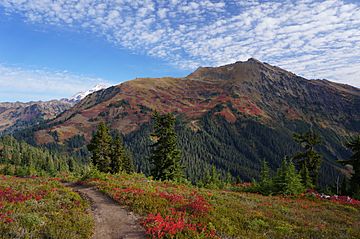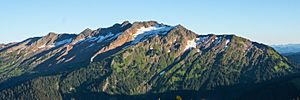Indian Head Peak facts for kids
Quick facts for kids Indian Head Peak |
|
|---|---|

Indian Head Peak from Pacific Crest Trail
|
|
| Highest point | |
| Elevation | 7,400 ft (2,300 m) |
| Prominence | 2,000 ft (610 m) |
| Isolation | 4.02 mi (6.47 km) |
| Parent peak | Kololo Peaks (8,200+ ft) |
| Geography | |
| Location | Chelan County, Washington, U.S. |
| Parent range | Cascade Range |
| Topo map | USGS Glacier Peak East |
| Climbing | |
| First ascent | 1870 |
| Easiest route | class 2 Scrambling |
Indian Head Peak is a tall mountain in Washington state, reaching about 7,400 feet (2,256 meters) high. It's found in the beautiful Glacier Peak Wilderness area, which is part of the North Cascades mountains. This mountain is in Chelan County and is looked after by the Okanogan-Wenatchee National Forest.
Its closest taller neighbor is Kololo Peaks, which is about 3.3 miles (5.3 km) north. Indian Head Peak is the second tallest spot on Wenatchee Ridge. Other peaks on this ridge include Mount Saul, Whittier Peak, and Mount David. Water flowing from the mountain goes into Indian Creek and the White River. These rivers then flow into the Wenatchee River. The mountain was named by Albert Hale Sylvester, an early explorer and surveyor in the Cascades.
How the Mountains Were Formed: Geology
The North Cascades mountains have a very rugged look. They feature sharp peaks, spires, and deep valleys carved by glaciers. These amazing shapes were created by geological events that happened millions of years ago. These events caused big changes in height across the Cascade Range, leading to different climates.
The Cascade Mountains started forming millions of years ago, during the late Eocene Epoch. This happened as the North American Plate slowly moved over the Pacific Plate. This movement caused many volcanic eruptions. Glacier Peak, a large volcano, started forming about 7.2 miles (11.6 km) north of Indian Head Peak. Because Glacier Peak is so close, you can find volcanic ash all over this area. Also, small pieces of the Earth's crust, called terranes, helped create the North Cascades about 50 million years ago.
During the Pleistocene period, which was over two million years ago, glaciers repeatedly moved across the land. As they moved, they scraped away rock and left behind rock debris. The river valleys in this area have a "U" shape because of these glaciers. The lifting of land (uplift) and cracks in the Earth's crust (faulting), along with the glaciers, have shaped the tall peaks and deep valleys of the North Cascades.
Weather and Climate
Indian Head Peak is in a marine west coast climate zone. This means it gets a lot of moisture from the Pacific Ocean. Most weather systems start over the Pacific Ocean and move northeast towards the Cascade Range. As these weather systems hit the tall peaks of the Cascades, they are forced to rise. This causes them to drop their moisture as rain or snow onto the mountains. This effect is called Orographic lift.
Because of this, the western side of the North Cascades gets a lot of rain and snow, especially in winter. The snow here tends to be wet and heavy due to the ocean's influence. This can lead to a high risk of avalanches. Since the climate is mild and close to the Pacific Ocean, temperatures rarely go below 0°F (-18°C) or above 80°F (27°C) on the west side of the Cascade Crest.
In winter, the weather is usually cloudy. But in summer, high-pressure systems over the Pacific Ocean often bring clear skies. The best time to visit or climb Indian Head Peak is usually from July through September, when the weather is most pleasant.




